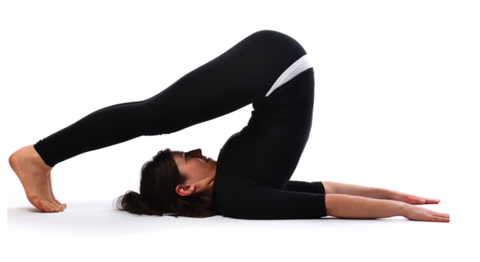The Sanskrit word Hala means plow, as in a traditional plow that is drawn by a horse or oxen. When performing this posture your body resembles a plow. Halasana is a yoga exercise of more or less same variety as sirsasana and sarvangasana. The stretching movement gives an addtional benefit in making you flexible and strengthen your spine and back muscles. It is helpful in curbing indigestion, constipation and acid reflux which is very common and very irritating disorders and cant let you to perform your work normally.
Hala Asana : The Plow Pose - Detailed Description
Steps:
- Lie flat on the back in the shava-asana.
- Inhale through the nostrils. Place the palms face-down on the floor. Keeping the hips on the floor, bend the knees and bring them up toward the stomach while exhaling.
- Inhale, then while exhaling, raise the legs straight up perpendicular to the floor. You may support your hips with your hands or leave the arms flat on the floor, whichever is most comfortable.
- Exhale and continue to raise the legs over the head, bending at the waist, lifting the back and buttocks until the toes touch the floor directly in back of the head. Keep the feet together. If the lower back is supported by the hands try returning the arms flat to the floor with the palms facing down. If you are unable to comfortably place the arms on the floor continue to support the lower back with the hands.
- Keep the knees straight. Breath slowly through the nostrils and hold the posture for several minutes. If you cannot touch the floor with your toes hold them as close to the floor as possible and continue to exert effort to lower them.
- Reverse the steps to return to the shava-asana.
- The benefits of this posture, like the sarvanga-asana, are numerous. All of the muscles and ligaments in the calves and thighs are stretched resulting in greater leg flexibility. People suffering from leg cramps will find great relief from the hala-asana.
- Since the abdominal area is contracted, blood compressed out of this area releases toxins and when the contraction is released the area is flooded with richly oxygenated blood.
- The contraction also helps to relieve gas and stimulates a sluggish digestive system.
- Similar effects take place as the neck and chest area is compressed effecting the throat, thyroid, parathyroid and lungs.
- Upper and lower back pain or discomfort is relieved due to the forward stretching of the spine.
- It is highly recommended that this posture be accompanied by the sarvanga-asana. In fact, many of the benefits of the sarvanga-asana apply to the hala-asana as well with the added benefits detailed above.
- The hala-asana is an excellent morning posture although some might find it more difficult then. During sleep the spine can become somewhat compressed resulting in the experience of tightness or stiffness in the back. A few repetitions of the hala-asana will quickly restore flexibility to the spine as well as promote alertness.







0 Comments